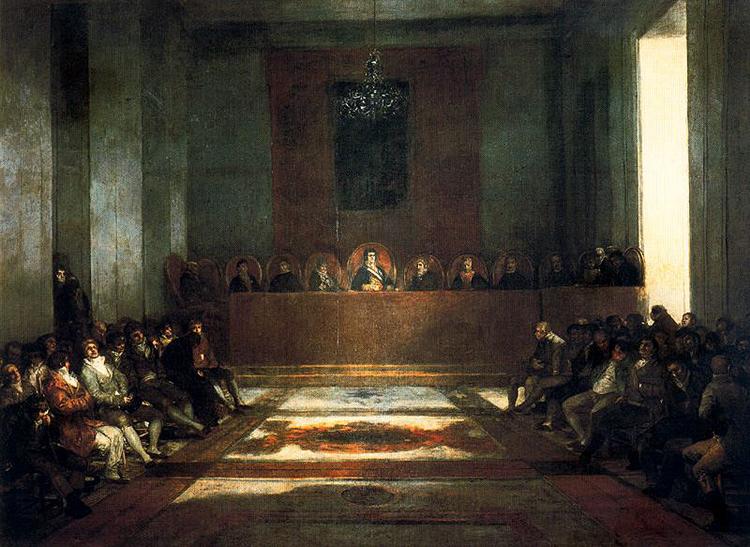Beschreibung
Das Philippines Board, das 1815 von Francisco Goya gemalt wurde, ist aufgrund seines historischen Kontextes und seiner besonderen Komposition ein bedeutendes Werk, der sowohl den Einfluss der Romantik als auch die Verbindung des Künstlers mit den politischen Ereignissen seiner Zeit widerspiegelt. Obwohl die Malerei im Vergleich zu seinen emblematischsten Meisterwerken wie "3. Mai 1808" weniger bekannt ist, ist seine Relevanz in der Darstellung der politischen und sozialen Spannung des frühen 19. Jahrhunderts.
Die Arbeit präsentiert eine Gruppe von Zahlen in einer Umgebung, die auf einen kritischen Moment der Überlegung und Entscheidung hinweist. In der Mitte sticht die Figur des Präsidenten des Philippinen -Verwaltungsrates sofort auf, umgeben von anderen Mitgliedern, die sich hauptsächlich hauptsächlich diskutieren. Goya erfasst die Dynamik des Ideenaustauschs, eine Darstellung, die die Bedeutung des Dialogs für die Bildung von Verwaltungsrichtlinien und Entscheidungen während einer Zeit der Instabilität hervorruft. Die Ausdrücke der Charaktere liegen zwischen Entschlossenheit und Sorge, was dem Betrachter ein Fenster für die inhärenten Spannungen in der Regierungsführung dieser Zeit bietet.
Die Komposition ist geschickt strukturiert, mit einer bewussten Nutzung des Raums, der die Sicht des Betrachters durch die Szene führt. Die Platzierung der Figuren und die Richtung ihrer Augen deuten auf eine Hierarchie und eine Interaktion hin, die Reflexion einlädt. Goya verwendet Chiaroscuro -Techniken, wodurch ein Kontrast zwischen Lichtern und Schatten erzeugt wird, der der Arbeit Tiefe verleiht und die Ernsthaftigkeit des Treffens betont.
Die Verwendung von Farbe ist auch erwähnt. Die Palette ist nüchtern, überwiegend die dunklen und schrecklichen Töne, die den Sinn für Graviten und die Feierlichkeit der Begegnung verstärken. Diese chromatische Auswahl enthält die leuchtenden Farben des dekorativen Malerei und spiegelt ein ernsthafteres und kontemplatives Thema wider, das die Gravitation der in diesem Board diskutierten Themen festhält.
Ein tieferer Blick spiegelt Goyas Interesse an sozialen und politischen Konflikten wider, was in seiner Arbeit eine Konstante ist. Seine Fähigkeit, das Politische mit dem Menschen zu verschmelzen und intime Porträts historischer Charaktere zu schaffen, ist in dieser Arbeit besonders offensichtlich. Obwohl es sich nicht um eine der berühmtesten Kompositionen von Goya handelt, verkauft das Philippinen -Board seine kritische Vision und seine Fähigkeit, die Komplexität des menschlichen Zustands im Rahmen von Institutionen darzustellen.
Goya ist bekannt für seinen Übergang von Rococó zur Romantik, und diese Arbeit kann als Brücke zwischen diesen Stilen angesehen werden. Die Herangehensweise an die Psychologie der Charaktere und das Drama, das ihrer Repräsentation inhärent ist, sind aktuell, die die zeitgenössische Kunst vorwegnehmen. In diesem Sinne können Sie einen Dialog mit anderen Malern ihrer Zeit aufbauen, die auch Politik und Gesellschaft durch ihre Kunst erforschten, wie Eugène Delacroix und ihre berühmte Arbeit "Freiheit, die die Menschen leitet", die zwar auch jüngsten, auch den Kampf verkörpert für die Freiheit und Darstellung des Volkes.
Zusammenfassend ist das Philippines Board eine Arbeit, die zwar weniger anerkannt ist, eine reichhaltige visuelle und konzeptionelle Erforschung des historischen Moments, den es darstellt, eine reichhaltige visuelle und konzeptionelle Erforschung bietet. Durch seine Zusammensetzung reagiert die Verwendung von Farbe und die Darstellung menschlicher Figuren in einem Kontext politischer Spannungen auf eine visuelle Sprache, die mit den Bedenken seiner Zeit in Verbindung steht und die Entwicklung der Malerei im neunzehnten Jahrhundert vorwegnimmt. Das Werk wird somit zu einem Zeugnis von Francisco Goyas Talent, den Geist seiner Zeit zu fangen und zeitgenössische Zuschauer die Möglichkeit zu bieten, über die Geschichte und ihre Resonanzen in der Gegenwart nachzudenken.
KUADROS ©, eine berühmte Farbe an Ihrer Wand.
Handgemachte Ölgemälde, mit der Qualität professioneller Künstler und dem unverwechselbaren Siegel von KUADROS ©.
Pictures Reproduction Service mit Zufriedenheitsgarantie. Wenn Sie mit der Nachbildung Ihres Gemäldes nicht vollständig zufrieden sind, erstatten wir Ihr Geld zu 100%.

